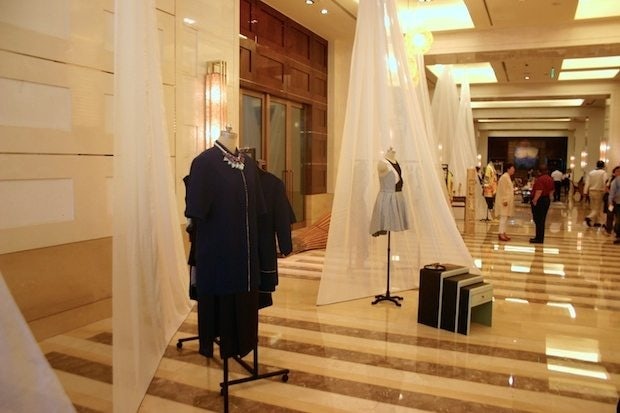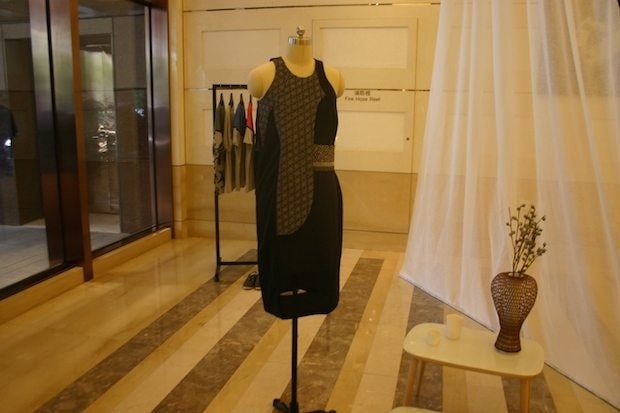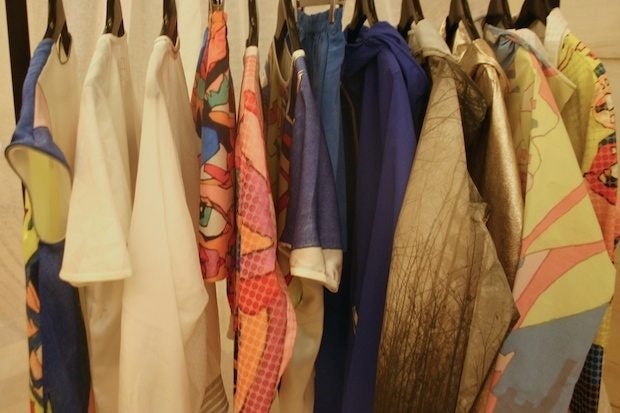
Wuhao's pop-up at the Four Seasons hotel in Beijing. (Jing Daily)
As Chinese shoppers have become increasingly interested in small niche fashion labels and multi-brand boutiques have been popping up in trendy neighborhoods across Beijing and Shanghai, Beijing-based curated multi-brand boutique Wuhao has been there from the beginning. Founded in 2010 by France natives Virginie Kompalitch and Isabelle Pascal, the shop originally featured its avant-garde selection of pieces by Chinese and international designers at a historic hutong courtyard home that had once belonged to Wanrong, the empress of China’s last emperor Puyi. The original location, which was directed by Pascal until the end of 2013, was based on a concept of the Chinese five elements and four seasons, it also served as a gallery with frequent art installations, making it a go-to destination for anyone on the cutting edge of China’s creative scene.
For the past year since Wuhao has moved out of the courtyard home under the directorship of Kompalitch, it has expanded its reach and staged a series of themed pop-up concepts at chic locations around Beijing. This month, the shop held its third pop-up at the Four Seasons Hotel, which was inspired by a “Nature” theme and arranged in two parts. The first featured a curated collection of clothes, art, home products, and accessories by labels including Malaysian designer Cassey Gan, Chinese designer Wang Yifang, and Beijing-based MPMP, while the second part was exclusively dedicated to the collection of Georgian designer Irakli Nasidze.
In order to learn more about Wuhao’s concept and get an insider look at China’s niche fashion scene, we met with Kompalitch at the Four Seasons pop-up for an interview about what goes into the curation process, Chinese consumers’ growing taste for new labels, and her favorite up-and-coming labels.
What inspired you to start Wuhao?#
We were both French and we heard a lot about things “made in China,” and we were willing to explore the concept of “made by China” or “designed in China.” We tried to explore creativity in China, and we started to work with young designers in China. I’m based in Paris and I’m traveling a lot, so it was also to see the interest from designers for crossovers and collaborations, and the interest of bringing foreign designers to China and bringing Chinese designers to Western countries. The idea was really to create the link in a community of designers and create projects like that.

Wuhao's pop-up at the Four Seasons hotel in Beijing. (Jing Daily)
What is the theme of this pop-up?#
Actually, this current pop-up is about nature, so we have selected designers having their own vision of nature. It could be products made out of bamboo, for example—real natural products. It can also be porcelain and bone china made using leaves, for example, as motifs, or including leaves in their products. Or, it could be fashion designers using nature for the color or the fabric coming from nature. It was the same thing but different interpretations from different designers, and actually, for this pop-up, there are two different steps. The first one is the selection of different designers sharing this inspiration of nature, and for the second step there is just one designer—Irakli Nasidze—that is his dream of nature. He is showing his collection in Asia for the first time, and it’s really his dream of women working in a natural environment. It’s his exclusive installation.
How do you choose the designers that you feature?#
To choose the designer is always a story of people, so we meet them, we discuss with them, and if we like the concept, the people, the product, and the quality, we decide to work with them. We have long-term collaborations with most of them. It’s like they are part of our family, and we always call them the “Wuhao family.” We share the same attention to details, attention to quality, and we try to select special pieces from among their collections. We never have the entire collection of one designer. It’s always a selection of some of the pieces by the designers that match our concept, but creativity is really the first word when we select pieces.

A look by Malaysian designer Cassey Gan at Wuhao's pop-up at the Four Seasons hotel in Beijing. (Jing Daily)
What was the process for setting up the Irakli presentation and why did you choose to work with him on this?#
Actually, he came to our space in the hutong two or three years ago. That was his first trip to China and he was very impressed and very inspired by the location, and since that time, we’ve always had it in mind to collaborate in some way. He’s a fashion designer, but he’s also an artist. Here at the Four Seasons, the hotel is very interested in having art exhibitions, so that was the perfect location to ask him to come to curate the space, introducing both art and fashion at the same time. It was just the right moment with the right location, and the right people to do it.
Who are your typical customers?#
Our typical customers have changed a lot over the last year. For the first three years of Wuhao, we were in this hutong where we had very regular customers that were, I would say, half Chinese half foreigners—more artsy people, very connected to the latest trends and very interested in discovering new designers and new pieces. For the last 12 months, we’ve been moving around Beijing, and this is now the fifth exhibition we’re doing where basically we go in places where we are not known and we have a completely different audience and customers.
I would say now, our main customers are maybe between 25 and 40—mainly women; not that much aware of trends and latest designs, but very curious to see something they’ve never seen before. More often they are business people. They are not in a shopping mode when we find them because this is the concept when you do a pop-up in the lobby of a hotel. People are not expecting to shop there. So it’s completely different—we don’t have people coming because they want to buy something; it’s people going to a meeting and they see something they like and they switch to shopping mode, so it’s very different from a traditional shop.
How did you choose the Four Seasons?#
Actually we started last year—it’s the third time we are collaborating with the Four Seasons. We started last year because our concept was based on the five elements and four seasons. It really matches their concept easily, and we were the first shop or brand they invited for this pop-up shop. They were not sure how it would work, and were willing to invite a brand really telling a story, so we were first on their list, and when they did invite us, we said yes. We were very curious to see how it could work, because marble and gold, and this luxury environment is quite different from our hutong house that was collapsing. But actually, the one we did last year for the first time was a good surprise to see that our design also worked well with marble and not just in the very old house. It’s a good collaboration because of the concept, and because of their Four Seasons name—they like when things change with time, and that is what we are doing, so basically, our concepts have something really strong in common.

Wuhao's pop-up at the Four Seasons hotel in Beijing. (Jing Daily)
Would you say that Chinese shoppers have become more interested in niche fashion labels since you started Wuhao?#
Yes, definitely. I would say that Chinese shoppers—of course they ask about the brands, but they also ask about now the fabrics, they look at the cut, they try to understand why this is different from what they already have, and they are also very interested in advice on how to wear the pieces: what they should wear and how the color matches and also how to put accessories on the same piece to use it in different ways. I think more and more, we have very sophisticated discussions about fashion with our customers.
Who are some of your favorite emerging designers right now?#
I really like Wang Yifang—she’s from London and has really amazing cuts. And Cassey Gan that we have as well from Malaysia. She’s using fabric from Japan; she has very interesting patterns, and the way she’s using different prints and different patterns to create dresses is something quite new.

Wuhao's pop-up at the Four Seasons hotel in Beijing. (Jing Daily)
You started out with mostly Chinese designers and now you're incorporating a more international portfolio. Why did you decide to make that switch and how does it reflect Chinese consumers’ buying habits?#
I think what is interesting is to put together pieces from different designers that share a good inspiration and a good knowledge of how to make clothes. I think it’s not really that important where people are from, so we find it very interesting to create looks mixing products from Japanese, Korean, Malaysian, and Chinese designers—not just Chinese. So we’ve stopped a little bit selecting pieces only because they were by Chinese designers. Now, were are looking more at, “Is this a good product or not?” And we are feeling that our customers—our Chinese customers—they are interested to know where the designers come from, but it’s not the only selling point and it’s not just because it’s a Chinese designer that they will get the product. We like to find good Chinese designers, but it’s no longer the only thing.
You’ve moved from the hutong location to pop-up events. What’s next for Wuhao in the future?#
I must say we like the pop-up life that we have. We’ve done five in one year, and it’s quite exciting to have to create a story and a display for a new space and the customers we will see in that location. It’s also been quite inspiring for designers when they see pictures of our previous pop-up and we tell them we are preparing the next one, they are all quite excited to do something for this special event. I think we will keep doing pop-ups for a while. We have some proposals for outside of Beijing, so we might go a little bit further from here, but of course, we also would like to find a permanent space, so we are still thinking and looking around for collaboration and opportunities. We haven’t found the perfect space yet.